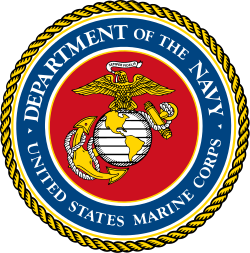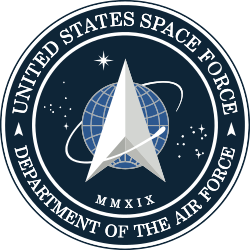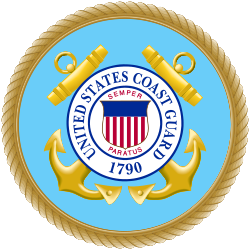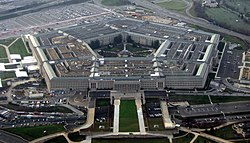Pentagon

Das Pentagon (deutsch „Fünfeck“; von gleichbedeutend griechisch πεντάγωνονpentágōnon) ist der Hauptsitz des Verteidigungsministeriums der Vereinigten Staaten. Der Begriff „Pentagon“ wird auch als Synonym für das US-Verteidigungsministerium benutzt.
Mit seinen je 280 Meter langen Außenwänden, einer Grundfläche von rund 135.000 Quadratmetern, einer Bürofläche von etwa 344.280 Quadratmetern und einem Volumen von rund 2 Millionen Kubikmetern ist es das fünfzehntgrößte Gebäude der Welt und das größte einzelne Verwaltungsgebäude. Es liegt am Potomac River in Arlington (Virginia) direkt neben dem Nationalfriedhof Arlington an der Grenze zu Washington, D.C. Die Gesamtlänge aller Korridore beträgt knapp 17,5 Meilen (ca. 28,2 km). Jeder Punkt im Bau ist von jedem anderen Punkt innerhalb des Gebäudes zu Fuß in unter sieben Minuten erreichbar.[1]
Geschichte
Baugeschichte

1941 litt das seinerzeit 23.000 Mitarbeiter umfassende Kriegsministerium unter akuter Platznot und war zudem auf 17 verschiedene Gebäude verteilt. Im Juli desselben Jahres ersuchte Brigadegeneral Brehon B. Somervell darum, diese Probleme durch einen Neubau zu lösen, der ursprünglich nur als Übergangslösung gedacht war.
Der US-Kongress hatte aufgrund der zu erwartenden hohen Baukosten zunächst Bedenken, gab jedoch am 14. August 1941 angesichts der Kriegssituation in Europa grünes Licht für den Bau und stellte die nötigen Mittel bereit. Für den drohenden Fall des Kriegseintritts der USA sollte das Verteidigungsministerium arbeitsfähig sein.
Ursprünglich sollte das Gebäude an einem anderen Standort gebaut werden. Das vorgesehene Bauland war unter dem Namen Arlington Farms bekannt und wurde von fünf Straßen eingerahmt, was die charakteristische Form des Gebäudes vorgab. Präsident Franklin D. Roosevelt fürchtete jedoch, der riesige Bürokomplex könne die Sicht vom Nationalfriedhof Arlington aus auf Washington (D.C.) beeinträchtigen, und ließ einen anderen Bauplatz suchen. Eine weitere Bedingung von Roosevelt war, für den Bau kein Material aus kriegführenden Staaten zu verwenden, womit vor allem Marmor (aus Italien) gemeint war. So musste das Pentagon aus Beton gebaut werden.
Den endgültigen Standort fand man 1,2 Kilometer flussabwärts am Potomac River. Hier befanden sich zuvor der alte Hoover-Airport, eine ehemalige Ziegelei, ein Rennplatz sowie eine ärmliche Siedlung, genannt Hell’s Bottom.
An der fünfseitigen Form hielt man fest und entwarf die endgültige Version mit freiem Innenhof. Jede Seite des Fünfecks besteht ihrerseits aus fünf parallelen Gebäudereihen (den sogenannten „Ringen“), so dass nur die Mitarbeiter ganz außen im Ring E oder innen im Ring A die Chance auf einen „Gartenblick“ haben. Außerdem hat jeder Ring fünf Stockwerke. Ein Vorteil der gewählten Bauart ist, dass man in ca. sieben Minuten jeden Ort im Pentagon erreichen kann.
Unter der Leitung von Colonel Leslie Groves, später militärischer Leiter des Manhattan-Projekts, und nach dem Entwurf des amerikanischen Architekten George Bergstrom (1876–1955), arbeiteten 14.000 Arbeiter und 1000 Architekten nun in drei Schichten rund um die Uhr. Am 11. September 1941 begonnen und nach 16 Monaten am 15. Januar 1943 fertiggestellt, kostete der Bau 83 Mio. US-Dollar.[2]
Beschädigung am 11. September 2001



Einer der Terroranschläge am 11. September 2001 galt dem Pentagon, das am 60. Jahrestag seines Baubeginns punktuell beschädigt wurde. Dabei kamen 184 Menschen ums Leben. Dank der befestigten Bauweise von 1941, die ursprünglich für die Lasten der Akten verstärkt ausgeführt wurde, gab es nicht mehr Tote. Auch die Sicherheitsfenster und die 2001 kurz vor den Anschlägen neu eingebaute bzw. überholte Sprinkleranlage retteten vielen Menschen im 1. Stock und in den angrenzenden Blöcken das Leben. Erst 19 Minuten nach dem Einschlag der Boeing 757 und dem Ausbrechen des Feuers brach der 1. Stock in sich zusammen.
Das Einschlagloch war anfangs fast nicht auszumachen, da die entführte Boeing 757 mittig auf ein Eisentor für Zulieferer auftraf und erst im Gebäude-Komplex in einer Kerosin-Feuerwolke explodierte.
Aufgrund der starken Beschädigungen am Gebäude, der extrem geringen Beschädigung um das Gebäude, widersprüchlicher Zeugenaussagen und des Vorenthaltens von Informationen (z. B. Videoaufnahmen) durch das Verteidigungsministerium kursieren mehrere von der sogenannten „offiziellen Version“ abweichende Verschwörungstheorien über den Anschlag.
Zum Jahrestag des Anschlags wurde im Jahr 2008 eine Gedenkstätte für die Opfer eingeweiht, das Pentagon Memorial.
Schusswechsel am 4. März 2010
Am Abend des 4. März 2010 schoss der 36 Jahre alte, aus Hollister in Kalifornien stammende US-Bürger John Patrick Bedell, ein Anhänger der Verschwörungstheorien zum 11. September 2001, am Haupteingang mit einer Pistole auf zwei Sicherheitskräfte und verletzte sie leicht. Sie erwiderten daraufhin das Feuer und töteten Bedell durch einen Kopfschuss.
Status des Gebäudes
Am 27. Juli 1989 wurde das Pentagon als Gebäude in das National Register of Historic Places eingetragen.[3] Seit dem 5. Oktober 1992 hat es den Status einer National Historic Landmark und ist somit eine von 121 historischen Stätten dieser Art in Virginia.[4]
Zwischen 1994 und 2011 wurde das Pentagon renoviert. Allein die Planung dauerte mehr als ein Jahrzehnt und kostete mehr als eine Milliarde US-Dollar. Die Renovierung des am 11. September 2001 zerstörten Sektors war beinahe abgeschlossen gewesen. Der Wiederaufbau geschah gleichzeitig mit der Renovierung des zweiten Sektors, die im Oktober 2005 abgeschlossen wurde. Im Oktober 2007 wurde die Renovierung des dritten Sektors abgeschlossen. Die anschließende schrittweise Renovierung der letzten beiden Sektoren war 2011 beendet. Die Gesamtkosten beliefen sich auf 4,5 Milliarden Dollar.[5]
Führung der Streitkräfte
Das Pentagon soll mit den Streitkräften durch ein spinnennetzartiges globales Kommunikationssystem verbunden werden, das Global Information Grid.
Siehe auch
Weblinks
- magazinUSA.com – „The Pentagon – Geschichte und Fakten“
- Das Pentagon als 3D-Modell im 3D Warehouse von SketchUp
Einzelnachweise
- ↑ Quelle: FAQ des US-Verteidigungsministeriums über sich selbst. Eingesehen am 23. Februar 2013
- ↑ Entspricht heute ca. 1.510.000.000 Euro. Diese Zahl wurde mit der Vorlage:Inflation ermittelt und gilt für den Januar des laufenden Jahres.
- ↑ Pentagon Office Building Complex im National Register of Historic Places, abgerufen am 8. März 2020.
- ↑ Listing of National Historic Landmarks by State: Virginia. National Park Service, abgerufen am 8. März 2020.
- ↑ Pentagon-Renovierung nach 17 Jahren beendet ORF.at
Koordinaten: 38° 52′ 16″ N, 77° 3′ 21″ W
Auf dieser Seite verwendete Medien
Seal of the United States Department of Defense from 2001 to 2022.
Seal of the United States Department of Defense from 2001 to 2022.
Seal of the United States Marine Corps. It is defined in Executive Order 10538 (alternate source) as:
For more information, see here.Standing upon the western hemisphere of the terrestrial globe containing the lines of latitude and topographical outlines of North, Central, and South America, an American bald eagle with wings displayed horizontally and inverted holding in his beak a scroll inscribed with the motto SEMPER FIDELIS, all bronze. Behind the western hemisphere a foul anchor bend sinister-wise with stock, arms, and flukes in slight perspective, all bronze, on a scarlet background and within a dark blue band edged in gold circumscribed by a gold rope rim and inscribed DEPARTMENT OF THE NAVY • UNITED STATES MARINE CORPS in gold letters. The central device of the seal is the emblem of the United States Marine Corps.
Seal of the United States Marine Corps. It is defined in Executive Order 10538 (alternate source) as:
For more information, see here.Standing upon the western hemisphere of the terrestrial globe containing the lines of latitude and topographical outlines of North, Central, and South America, an American bald eagle with wings displayed horizontally and inverted holding in his beak a scroll inscribed with the motto SEMPER FIDELIS, all bronze. Behind the western hemisphere a foul anchor bend sinister-wise with stock, arms, and flukes in slight perspective, all bronze, on a scarlet background and within a dark blue band edged in gold circumscribed by a gold rope rim and inscribed DEPARTMENT OF THE NAVY • UNITED STATES MARINE CORPS in gold letters. The central device of the seal is the emblem of the United States Marine Corps.
Seal of the United States Space Force.
Seal of the United States Department of Homeland Security. A graphically styled American eagle appears in a circular blue field. The eagle's outstretched wings break through an inner red ring into an outer white ring that contains a circular placement of the words "U.S. DEPARTMENT OF" in the top half and "HOMELAND SECURITY" in the bottom half. The outer white ring has a silvery gray border. As in The Great Seal, the eagle’s left claw holds an olive branch with 13 leaves and 13 seeds while the right claw grasps 13 arrows. Centered on the eagle's breast is a shield divided into three sections containing elements that represent the homeland "from sea to shining sea." The top element, a dark blue sky, contains 22 stars representing the original 22 agencies and bureaus that have come together to form the department. The left shield element contains white mountains behind a green plain underneath a light blue sky. The right shield element contains four wave shapes representing the oceans, lakes and waterways alternating light and dark blue separated by white lines.
United States Coast Guard Seal, in correct PMS colors. This emblem shall only be used in accordance with the Coast Guard Heraldry Manual, and is not to be reproduced commercially without prior approval of the U.S. Coast Guard.
United States Coast Guard Seal, in correct PMS colors. This emblem shall only be used in accordance with the Coast Guard Heraldry Manual, and is not to be reproduced commercially without prior approval of the U.S. Coast Guard.
U.S. Department of The Army Emblem.
- In the center is a Roman cuirass below a vertical unsheathed sword, point up, the pommel resting on the neck opening of the cuirass and a Phrygian cap supported on the sword point, all between on the right an esponton and on the left a musket with fixed bayonet crossed in saltire behind the cuirass and passing under the sword guard.
- To the right of the cuirass and esponton is a flag of unidentified designs with cords and tassels, on a flagstaff with spearhead, above a cannon barrel, the muzzle end slanting upward behind the cuirass, in front of the drum, with two drumsticks and the fly end of the flag draped over the drumhead; below, but partly in front of the cannon barrel, is a pile of three cannon balls.
- To the left of the cuirass and musket is a national color of the Revolutionary War period, with cords and tassels, on a flagstaff with spearhead, similarly arranged above a mortar on a carriage, the mortar facing inward and in front of the lower portion of the color and obscuring the lower part of it; below the mortar are two bomb shells placed side by side.
- Centered above the Phrygian cap is a rattlesnake holding in its mouth a scroll inscribed "This We'll Defend."
- Centered below the cuirass are the Roman numerals "MDCCLXXVIII."
- For differences between this text description and the emblem shown above, see "Army Seal vs. Army Emblem", below.
Seal of United States Department of the Air Force - military department for the United States Air Force and the United States Space Force
Pentagon security video (5 of 9)
*Description: On a circular background of fair sky and moderate sea with land in sinister base, a tri-mast square rigged ship under way before a fair breeze with after top-sail furled, commission pennant atop the foremast, National Ensign atop the main, and the commodore's flag atop the mizzen. In front of the ship a luce-type anchor inclined slightly bendwise with the crown resting on the land and, in front of the shank and in back of the dexter fluke, an American bald eagle rising to sinister regarding to dexter, one foot on the ground, the other resting on the anchor near the shank; all in proper colors. The whole within a blue annulet bearing the inscription "Department of the Navy" at the top and "United States of America" at the bottom, separated on each side by a mullet and within a rim in the form of a rope; inscription, rope, mullet, and edges of annulet all gold. *Background: The policy for use of the Navy seal and emblem is contained in SECNAV Instr 5030.4 and SECNAV Instr 5030.6. The seal design was approved by the President of the United States by Executive Order 10736 dated October 23, 1957. Request for use of the Navy emblem should be submitted in writing to Defense Printing Service, ATTN: DPSMO, 8725 John Kingman Rd Suite 3239, Fort Belvoir, VA 22060-6220. The telephone number is (703) 767-4218. 1879 version here: http://etc.usf.edu/clipart/54900/54985/54985_seal_navy.htm
Aerial view of the Pentagon Building located in Arlington, Virginia showing emergency crews responding to the destruction caused when a hijacked commercial jetliner crashed into the southwest corner of the building, during the 9/11 terrorists attacks.
Autor/Urheber: Max Lankau, Lizenz: CC BY-SA 3.0
| Beschreibung |
Das ist die gesprochene Version des Wikipedia-Artikels: Pentagon |
| Dialekt | Hochdeutsch |
| Geschlecht | Männlich |
| Dauer | 9:19 |
| Datum | |
| Quelle |
|
| Urheber |
Sprecher: Max Lankau |
Autor/Urheber: Ralf Roletschek (talk) - Infos über Fahrräder auf fahrradmonteur.de, Lizenz: CC BY-SA 3.0
Friedhof Arlington
Autor/Urheber: David B. Gleason from Chicago, IL, Lizenz: CC BY-SA 2.0
The Pentagon, headquarters of the United States Department of Defense, taken from an airplane in January 2008













